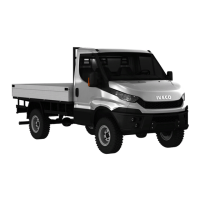DAILY 4x4 ‒ GUIDELINES FOR BODYBUILDERS
APPLICATIONS OF SUPERSTRUCTURES
3.10 TIPPER BODIES (BREAKDOWN RECOVERY)
25
– Printed 692.68.999 – 3 Ed. - Base 08-2020
3.10 TIPPER BODIES (BREAKDOWN RECOVERY)
The use of tipping bodies generally subjects the chassis to considerable mechanical stress. It is therefore necessary that the vehicle
is included in those permitted for this application as listed in Table 3.4 together with the general features of the subframe profile
required.
Where an extremely long flat body is necessary, it is preferable to use a vehicle that already has a sufficiently long wheelbase rather
than create a long overhang.
The subframe must be suitably sized and stiffened at the rear with box sections and cross braces (see Figure 6 and Figure 7).
The connections to the chassis must be flexible (brackets) at the front end, while the rear section requires stiff connections (plates)
to allow the added structure to contribute more to the stiffness of the assembly.
The rear tipping hinge must be fitted to the subframe and its longitudinal position must be as close as possible to the rear support
of the suspension. So as not to compromise vehicle stability during tipping operations and avoid excessive mechanical stress on the
chassis, the distance between the tipping hinge and the rear support of the suspensions must comply with the specifications given in
Figure 11. If this is not possible, larger than normal subframe profiles must be used together with additional stiffening at the rear.
Particular attention must be paid to the positioning of the lifting device both in terms of protecting the strength of the supports
and in order to correctly position the connections. it is therefore recommended that in order to reduce the extent of the localised
load, the lifting device is placed forwards of the centre of gravity of the payload-body assembly.
The Bodybuilder must equip the vehicle appropriately to ensure stability during tipping operations.
All equipment and structures must comply with any applicable national legislation.
3.11 VEHICLES FOR COUNCIL, FIRE PREVENTION AND SPECIAL USES
The outfitting of vehicles for municipal use (compactor trucks, road rollers; road cleaning vehicles) in many cases require:
● the realization of a particularly robust subframe towards the rear and elastic type connections to the chassis towards the front
of the vehicle;
● shortening of the rear overhang of the chassis.
When very short overhangs are necessary, the chassis may be shortened immediately downstream of the rear spring support
(or after the bar coupling in the case of air suspension), thus keeping intact the connection to the chassis of the crossbar ap-
plied therein;
● the adoption of rear suspensions with greater rigidity (see Chapter 2.11 );
● a new arrangement of the rear lights.
▶ Do not use the reversing light switch, mounted on the gearbox, to activate functions that
require increased reliability and safety levels, (e.g. engine stop during reverse, on vehicles for
urban waste collection from the personnel present on the rear footboards).
3.12 FRONT INSTALLATION OF SNOW PLOUGH ATTACHMENTS
The application of a snowplough attachment (blade or ploughshare) to the front part of the vehicle must be carried out using a
suitable support structure, appropriately anchored to the core of the chassis side members and in observance of the prescriptions
contained in Chapter 2.2 .
▶ Resistant structures which make use of struts or tie rods that act on the leaf spring and/or on
relative supports are strictly prohibited.
Since, when used to remove snow, the vehicle is weighted at the rear and the maximum speed is limited (e.g. 40 km/h), a small
increase in maximum axle load may be allowed upon specific assessment and authorisation by IVECO.

